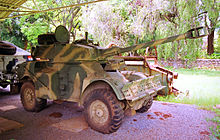Reconnaissance vehicle

United States Army M1127 Reconnaissance Vehicle

German Army Fennek reconnaissance vehicle
A reconnaissance vehicle, also known as a scout vehicle, is a military vehicle used for forward reconnaissance. Both tracked and wheeled reconnaissance vehicles are in service. In some nations, light tanks such as the M551 Sheridan and AMX-13 have also been used by scout platoons. Reconnaissance vehicles are usually designed with a low profile or small size and are lightly armoured, relying on speed and cover to escape detection. Their armament ranges from a medium machine gun to a large cannon. Modern examples are often fitted with ATGMs and a wide range of sensors.
Contents
1 Design
2 History
3 Role
4 List of contemporary reconnaissance vehicles
5 See also
6 References
Design
Smaller caliber weapons help reduce the vehicle's profile and noise signatures.[1] In contrast, French doctrine was to fit reconnaissance vehicles, such as the EBR and the AMX 10 RC, with the heaviest weaponry possible on their light chassis, so as to allow them a further role for defence of the flanks.
History
During World War II, the British generally used armoured cars for reconnaissance, from the machine gun armed Humber Light Reconnaissance Car and Daimler Dingo to the 6-pdr (57 mm) gun equipped AEC Armoured Car. Post war the British Army used the Ferret and later, Fox scout cars. In Japan, the Kurogane Type 95 was introduced as a reconnaissance vehicle for operations in China.[2]
The U.S. and UK experimented with the Future Scout and Cavalry System (FSCS) and Tactical Reconnaissance Armoured Combat Equipment Requirement (TRACER) programs in the 2000s aimed at creating a stealth reconnaissance vehicle capable of C-130 airlift.[3]
Prior to the 2003 invasion of Iraq, the Iraqi Army placed an emphasis on the use of light wheeled vehicles for reconnaissance, particularly Soviet-manufactured BRDM-2 and French-designed Panhard AML armoured cars. Each corps had an attached BRDM or AML battalion. These were allocated by division; every brigade headquarters and regular infantry battalion received a platoon of six. The Iraqis did not make competent use of these assets during the Gulf War, opting to depend on signals intelligence against the comparatively sophisticated Coalition.[4]
South African expeditionary forces in Angola also employed wheeled reconnaissance vehicles for their strategic and tactical mobility, sometimes engaging Angolan units up to brigade strength. Scout cars such as the Eland Mk7 were used to lure hostile T-34s or T-54/55s into prepared ambushes, where they were destroyed by heavier vehicles, ATGMs, and artillery.[5]
Role
Reconnaissance of enemy positions can involve firing upon the enemy in hopes of receiving return fire that gives away the enemy's position. This can make the reconnaissance vehicle vulnerable to return fire that may destroy the vehicle before the enemy's position can be relayed.[6]
Dismounted operations by armed scouts include observation post manning, reconnaissance of areas not traversable by vehicle, and marking enemy mine fields.[7]
CBRN reconnaissance vehicles can also detect weapons of mass destruction. They accompany regular reconnaissance vehicles and are fully protected against airborne threats.[8]
List of contemporary reconnaissance vehicles

Variants of the Soviet BRDM series remain in service with many countries.

Zimbabwean Eland.

Netherlands Lynx.

Argentine ERC-90 on parade.
 Alvis FV601 Saladin
Alvis FV601 Saladin AMX-10 RC
AMX-10 RC ASLAV
ASLAV BRDM-1
BRDM-1 BRDM-2
BRDM-2 Cadillac Gage Commando Scout
Cadillac Gage Commando Scout Coyote
Coyote Lynx
Lynx D-442 FÚG
D-442 FÚG Dozor-B
Dozor-B EBRC Jaguar
EBRC Jaguar EE-3 Jararaca
EE-3 Jararaca EE-9 Cascavel
EE-9 Cascavel Eland
Eland /
/ Fennek
Fennek FV702 Ferret
FV702 Ferret FV722 Fox
FV722 Fox FV101 Scorpion
FV101 Scorpion FV102 Striker
FV102 Striker FV107 Scimitar
FV107 Scimitar Sabre
Sabre Gagamba
Gagamba Type 87 RCV
Type 87 RCV LAV-25 Armored Reconnaissance Vehicle
LAV-25 Armored Reconnaissance Vehicle M1127
M1127 Mowag Spy
Mowag Spy Otokar Cobra
Otokar Cobra Panhard AML
Panhard AML Panhard ERC 90
Panhard ERC 90 Panhard VBL
Panhard VBL RBY MK 1
RBY MK 1 RG-35 4x4 RPU[9]
RG-35 4x4 RPU[9] Rooikat
Rooikat Schützenpanzer SPz 11-2 Kurz
Schützenpanzer SPz 11-2 Kurz Spähpanzer Luchs
Spähpanzer Luchs Namco Tiger
Namco Tiger VEC-M1
VEC-M1 VBC-90
VBC-90 Wiesel
Wiesel XAV
XAV
See also
- Scout car
References
^ "return fire"
^ "World's 1st mass-produced compact 4WD fully restored". The Asahi Shimbun. Retrieved 14 December 2016..mw-parser-output cite.citationfont-style:inherit.mw-parser-output qquotes:"""""""'""'".mw-parser-output code.cs1-codecolor:inherit;background:inherit;border:inherit;padding:inherit.mw-parser-output .cs1-lock-free abackground:url("//upload.wikimedia.org/wikipedia/commons/thumb/6/65/Lock-green.svg/9px-Lock-green.svg.png")no-repeat;background-position:right .1em center.mw-parser-output .cs1-lock-limited a,.mw-parser-output .cs1-lock-registration abackground:url("//upload.wikimedia.org/wikipedia/commons/thumb/d/d6/Lock-gray-alt-2.svg/9px-Lock-gray-alt-2.svg.png")no-repeat;background-position:right .1em center.mw-parser-output .cs1-lock-subscription abackground:url("//upload.wikimedia.org/wikipedia/commons/thumb/a/aa/Lock-red-alt-2.svg/9px-Lock-red-alt-2.svg.png")no-repeat;background-position:right .1em center.mw-parser-output .cs1-subscription,.mw-parser-output .cs1-registrationcolor:#555.mw-parser-output .cs1-subscription span,.mw-parser-output .cs1-registration spanborder-bottom:1px dotted;cursor:help.mw-parser-output .cs1-hidden-errordisplay:none;font-size:100%.mw-parser-output .cs1-visible-errorfont-size:100%.mw-parser-output .cs1-subscription,.mw-parser-output .cs1-registration,.mw-parser-output .cs1-formatfont-size:95%.mw-parser-output .cs1-kern-left,.mw-parser-output .cs1-kern-wl-leftpadding-left:0.2em.mw-parser-output .cs1-kern-right,.mw-parser-output .cs1-kern-wl-rightpadding-right:0.2em
^ Bill Yenne (2006). Secret Gadgets and Strange Gizmos: High-Tech (and Low-Tech) Innovations of the U.S. Military. Zenith Imprint. p. 97. ISBN 9781610607445. Retrieved 22 May 2011.
^ Bourque, Stephen. Jayhawk!: The VII Corps in the Persian Gulf War (2003 ed.). Diane Publishing Company. pp. 136–137. ISBN 978-0756728632.
^ Mobile firepower for contingency operations: Emerging concepts for US light armour forces
^ Groman, Jeff (1985). Weapons of war. Multimedia Publications (UK). p. 128. ISBN 978-1-85106-031-3. Retrieved 22 May 2011.
^ Michael Green, Greg Stewart (2004). Weapons of the Modern Marines. Zenith Imprint. ISBN 0-7603-1697-X. Retrieved 22 May 2011.
^ U.S. Army (December 2010). "Stryker Nuclear, Biological, and Chemical Reconnaissance Vehicle (NBCRV)". p. 93. Retrieved 22 May 2011.
^ http://defenceweb.co.za/index.php?option=com_content&view=article&id=15327:baes-reveals-rg35-rpu-variant&catid=50:Land&Itemid=105